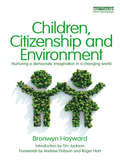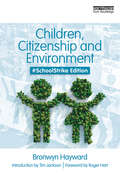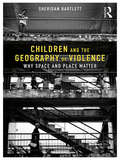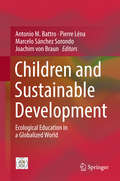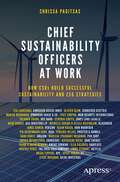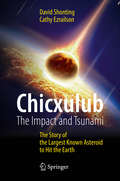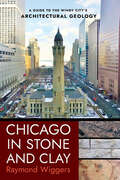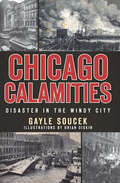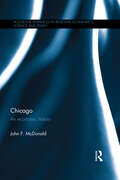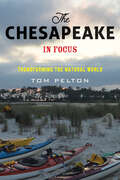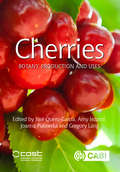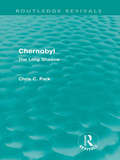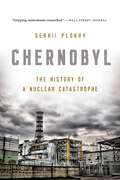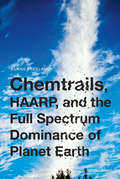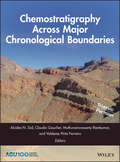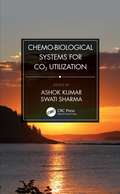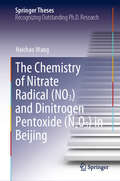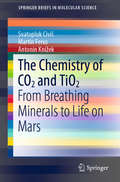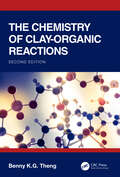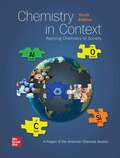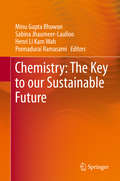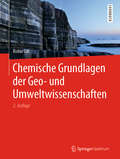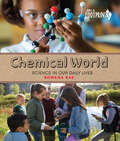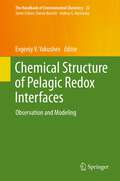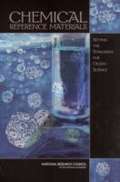- Table View
- List View
Children, Citizenship and Environment: Nurturing a Democratic Imagination in a Changing World
by Bronwyn HaywardChildren growing up today are confronted by four difficult and intersecting challenges: dangerous environmental change, weakening democracies, growing social inequality, and a global economy marked by unprecedented youth unemployment and unsustainable resource extraction. Yet on streets everywhere, there is also a strong, youthful energy for change. This book sets out an inspiring new agenda for citizenship and environmental education which reflects the responsibility and opportunities facing educators, researchers, parents and community groups to support young citizens as they learn to 'make a difference' on the issues that concern them. Controversial yet ultimately hopeful, political scientist Bronwyn Hayward rethinks assumptions about youth citizenship in neoliberal democracies. Her comparative discussion draws on lessons from New Zealand, a country where young citizens often express a strong sense of personal responsibility for their planet but where many children also face shocking social conditions. Hayward develops a 'SEEDS' model of ecological citizenship education (Social agency, Environmental Education, Embedded justice, Decentred deliberative democracy and Self transcendence). The discussion considers how the SEEDs model can support young citizens' democratic imagination and develop their 'handprint' for social justice. From eco-worriers and citizen-scientists to streetwise sceptics, Children, Citizenship and Environment identifies a variety of forms of citizenship and discusses why many approaches make it more difficult, not easier, for young citizens to effect change. This book will be of interest to a wide audience, in particular teachers of children aged eight to twelve and professionals who work in Environmental Citizenship Education as well as students and researchers with an interest in environmental change, democracy and intergenerational justice. Introduced by Tim Jackson, author of Prosperity without Growth, the book includes forewords by leading European and USA academics, Andrew Dobson and Roger Hart. Half the author's royalties will be donated to child poverty projects following the earthquakes in Christchurch, New Zealand. Follow Bronwyn Hayward's blog at: http://growing-greens.blogspot.co.nz/See Bronwyn Hayward discuss the book at: http://www.youtube.com/watch?v=kptEw1aZXtM&feature=youtu.be
Children, Citizenship and Environment: #SchoolStrike Edition
by Bronwyn HaywardIn this significantly revised second edition of Bronwyn Hayward’s acclaimed book Children Citizenship and Environment, she examines how students, with teachers, parents, and other activists, can learn to take effective action to confront the complex drivers of the current climate crisis including: economic and social injustice, colonialism and racism. The global school strikes demand adults, governments, and businesses take far-reaching action in response to our climate crisis. The school strikes also remind us why this important youthful activism urgently needs the support of all generations. The #SchoolStrike edition of Children Citizenship and Environment includes all new contributions by youth, indigenous and disability activists, researchers and educators: Raven Cretney, Mehedi Hasan, Sylvia Nissen, Jocelyn Papprill, Kate Prendergast, Kera Sherwood O’ Regan, Mia Sutherland, Amanda Thomas, Sara Tolbert, Sarah Thomson, Josiah Tualamali'i, and Amelia Woods. As controversial, yet ultimately hopeful, as it was when first published, Bronwyn Hayward develops her ‘SEEDS’ model of ‘strong ecological citizenship’ for a school strike generation. The SEEDS of citizenship education encourage students to develop skills for; Social agency, Environmental education, Embedded justice, Decentred deliberation and Self-transcendence. This approach to citizenship supports young citizens’ democratic imagination and develops their ‘handprint’ for social justice. This ground-breaking book will be of interest to a wide audience, in particular teachers and professionals who work in Environmental Citizenship Education, as well as students and community activists with an interest in environmental change, democracy and intergenerational justice.
Children and the Geography of Violence: Why Space and Place Matter
by Sheridan BartlettViolence sabotages development, both children’s development and the development of the communities and neighbourhoods they rely on. There is abundant evidence of the deep and lasting harm that can be done. Violence breaks bodies and minds and exerts an insidious influence at every level. The effects are immediate but can also linger, damaging health, trust and capability, traveling through generations. This book argues that it is impossible to understand the violence in young children’s lives or to respond to it adequately without considering how embedded it is within their physical surroundings. The relations of power that are the context for violence within households, within communities and beyond are often expressed through control over space and the material conditions of life. This book links the abstract concept of structural violence to the stark reality of personal harm, drawing on evidence from a range of disciplines and from countries throughout the global South. It explores the dynamics of cramped, insecure housing, poor water and sanitation, neglected neighbourhoods, forced evictions, cities that segregate the rich and the poor, landscapes of conflict and disaster, and discusses their implications for young children. An alternative approach to child protection is proposed, anchored in the actions of organized communities negotiating to challenge inequities, mend their environments and achieve security. There is a fundamental synergy between building community and protecting children. These are not separate agendas. A place that works for children works better for everyone else as well. This book will be essential reading for all those interested in young children in a global context, whether as child protection professionals, or those with a more general interest in children’s rights issues or in cross cultural approaches to child development. It will also be of great interest to students and researchers of development studies, conflict studies, family studies, child development, public health and urban planning.
Children and Sustainable Development: Ecological Education in a Globalized World
by Antonio M. Battro Joachim Von Braun Pierre Léna Marcelo Sánchez SorondoThis book addresses the changes in education practices, especially basic education, necessitated by the global challenges of climate change and sustainable development and in a context characterized by increasing poverty and inequality, migration and refugees. Written by a range of international scholars, scientists and grassroots practitioners from Africa, Latin America, Asia (India, China, Malaysia) and Europe, the individual contributions focus on education policies and child development in various social contexts. Case-based experiences from both developed and developing countries provide inspiration and shed new light on the fundamental changes needed to adapt existing school systems and teacher training to face the challenges of the future. In this regard, the need to empower children themselves is emphasized. All contributions are based on a Workshop hosted in November 2015 by the Pontifical Academy of Sciences at the Vatican entitled "Children and Sustainable Development: A Challenge for Education" and follow three other significant events on sustainable development in 2015, namely the publication of Laudato Si', the Encyclical Letter from Pope Francis, the release of the United Nations Sustainable Development Goals, and the COP21 Conference in Paris.
Chief Sustainability Officers At Work: How CSOs Build Successful Sustainability and ESG Strategies
by Chrissa PagitsasRead over 20 exclusive, in-depth interviews with chief sustainability officers (CSOs) of Fortune 500 companies such as Amazon, Coca-Cola, and Procter & Gamble and globally recognized brands such as IKEA and Netflix. These CSOs reveal how they deliver positive environmental and social impact through their companies’ core products and services and generate revenue growth while tackling unique leadership, change management, regulatory and stakeholder challenges. Sustainability and environmental, social, governance (ESG) strategies are increasingly central to businesses’ growth strategy and risk management. As a result, the CSO has become more important as a driver of both revenue and strategy. Yet, no two CSOs are alike in their backgrounds, titles or even the scope of their roles. From former Peace Corps volunteers to supply chain experts, these C-suite leaders launch ambitious carbon emissions and net-zero goals, develop new products for a circular economy, target increasing the diversity of their company’s staff, align strategic projects to the UN Sustainable Development Goals and standardize reporting for the SEC, investors and more. What You Will Learn How global multibillion dollar businesses in the United States, Europe and Asia structure their sustainability strategyHow top sustainability executives drive both business value and positive environmental and social impact How CSOs landed in their roles without climbing a traditional career ladder Who This Book Is ForExecutives and board members generally or those establishing a sustainability or ESG strategy; current and aspiring CSOs and ESG leaders; business leaders partnering with sustainability leaders and teams; and students studying the integration of sustainability and business.Advance praise for Chief Sustainability Officers At Work:"Chief sustainability officers play a critical role in supporting the broader business transition to a more just and sustainable global economy. Through dialogue with influential sustainability professionals, Chrissa brings to life the essential role in bridging gaps and helping to eliminate the divide between "traditional" business functions, senior leadership, and the sustainability teams to drive transformational change within their firms." - Mindy Lubber, CEO and President, Ceres "Chief Sustainability Officers at Work, is a fresh new book by seasoned business leader Chrissa Pagitsas that offers succinct ways anyone can implement and achieve ESG goals – whether they own the company or simply aspire to improve its impact on people and the planet. Chrissa roots this book in her own experience leading change within major companies that not only improved the businesses where she worked but improved the markets within which they needed to thrive. This is a must read for a seasoned ESG practitioner as much as it is for the young professional just getting started. Chrissa knows it is imperative we all just get started doing better and she opens up the otherwise dark box of how-tos for all of us to do our part." – Dana Bourland, SVP, The JPB Foundation and author of Gray to Green Communities: A Call to Action on the Housing and Climate Crises.
Chicxulub: The Story of the Largest Known Asteroid to Hit the Earth (Springer Praxis Books)
by Cathy Ezrailson David ShontingThis book tells the story of the catastrophic impact of the giant 10 Km asteroid Chicxulub into the ancient Gulf of Mexico 65. 5 million years ago. The book begins with a discussion of the nature of asteroids and the likelihood of future Earth-impacts. The story then turns to the discovery of a global sediment layer attributed to the fallout from the impact and a piecing together of the evidence that revealed a monster crater, buried under the Gulf. Reviewed is the myriad of geological and fossil evidence that suggested the disastrous sequence of events occurring when a "nuclear-like" explosion ripped through the sea, Earth, and atmosphere, thus forming the mega-crater and tsunami. The aftermath of the Chicxulub's event initiated decades and more of major global climate changes including a "Nuclear Winter" of freezing darkness and blistering greenhouse warming. A chapter is dedicated to the science of tsunamis and their model generation, including a portrayal of the globally rampaging Chicxulub waves. The asteroid's global devastation killed off some 70% of animal and plant life including the dinosaurs. The study of an ancient Cambrian fossil bed suggests how "roll of the dice" events can affect the future evolution of life on Earth. We see how Chicxulub's apparent destruction of the dinosaurs, followed by the their replacement with small mammals, altered forever the progress of human evolution. This book presents a fascinating glimpse through the lens of the natural sciences - the geology, climatology, and oceanography, of the effects of an enormous astronomical event.
Chicago in Stone and Clay: A Guide to the Windy City's Architectural Geology
by Raymond WiggersChicago in Stone and Clay explores the interplay between the city's most architecturally significant sites, the materials they're made of, and the sediments and bedrock they are anchored in. This unique geologist's survey of Windy City neighborhoods demonstrates the fascinating and often surprising links between science, art, engineering, and urban history. Drawing on two decades of experience leading popular geology tours in Chicago, Raymond Wiggers crafted this book for readers ranging from the region's large community of amateur naturalists, "citizen scientists," and architecture buffs to geologists, architects, educators, and other professionals seeking a new perspective on the themes of architecture and urbanism. Unlike most geology and architecture books, Chicago in Stone and Clay is written in the informal, accessible style of a natural history tour guide, humanizing the science for the nonspecialist reader. Providing an exciting new angle on both architecture and natural history, Wiggers uses an integrative approach that incorporates multiple themes and perspectives to demonstrate how the urban environment presents us with a rich geologic and architectural legacy.
Chicago Calamities: Disaster in the Windy City (Disaster Ser.)
by Gayle SoucekFire and flood, train wreck and tornado—a look at the many disasters Chicago has endured over the years, with photos and illustrations. The story of Chicago is often likened to that of a phoenix rising out of the ashes of the Great Fire. Yet that infamous event was only part of the destruction that has shaped Chicago&’s identity. This unique history explores the calamities that have befallen the Windy City, such as the 1954 killer water surge that swept in on a calm summer day; the 1967 tornado that ripped through rush hour traffic; the 1886 Haymarket Square riot that put Chicago on the anarchist map; and many other acts of nature and human folly. As you witness a fireproof theater burn, a flood rise up without rain, and one of the greatest maritime disasters occur within city limits, you&’ll gain a new appreciation for how this city has endured through unexpected tragedies and produced many unlikely heroes.
Chicago: An economic history (Routledge Advances in Regional Economics, Science and Policy)
by John F. McDonaldChicago went from nothing in 1830 to become the second-largest city in the nation in 1900, while the Midwest developed to become one of the world’s foremost urban areas. This book is an economic history of the Chicago metropolitan area from the 1820s to the present. It examines the city in its Midwestern region and compares it to the other major cities of the North. This book uses theories of the economics of location and other economic models to explain much of Chicago’s history. Chicago maintained its status as the second-largest city through the first decades of the 20th century, but rapid growth shifted to the Sunbelt following World War II. Since the 1950s the city’s history can be divided into four distinct periods; growth with suburbanization (1950-1970), absence of growth, continued suburbanization, and central city crisis (1970-1990), rebound in the 1990s, and financial crisis and deep recession after 2000. Through it all Chicago has maintained its position as the economic capital of the Midwest. The book is a synthesis of available literature and public data, and stands as an example of using economics to understand much of the history of Chicago. This book is intended for the college classroom, urban scholars, and for those interested in the history of one of world’s foremost urban areas.
The Chesapeake in Focus: Transforming the Natural World
by Tom PeltonThe people, policies, and forces transforming a national treasure—the Chesapeake Bay.When Captain John Smith arrived in Virginia in 1607, he discovered a paradise in the Chesapeake Bay. In the centuries that followed, the Bay changed vastly—and not for the better. European landowners and enslaved Africans slashed, burned, and cleared the surrounding forests to grow tobacco. Watermen overfished oysters, shad, and sturgeon, decimating these crucial species. Baltimore, Washington, and Richmond used its rivers as urban sewers. By the 1960s, the Chesapeake was dying.A crossroads of life and culture, the Chesapeake straddles the North and the South, mixes salt water with fresh, and is home to about 18 million people and 3,600 species of animals and plants. Although recent cleanup efforts have improved its overall health, they have not been enough to save this national treasure. In The Chesapeake in Focus, award-winning writer Tom Pelton examines which environmental policies have worked and which have failed. Based on Pelton’s extensive experience as a journalist and as the host of the public radio program The Environment in Focus, this sweeping book takes readers on a tour of the histories of the Chesapeake, as well as the ecological challenges faced by its major tributaries. It details the management of blue crabs, striped bass, and other delicious wildlife, profiles leaders and little-known characters involved in the restoration campaign, and warns of the dangers of anti-regulatory politics that threaten to reverse what has been accomplished. Looking to the future, Pelton offers a provocative vision of the hard steps that must be taken if we truly want to save the Bay.
Cherries
by J. Quero-García Amy Iezzoni Joanna Puławska Gregory LangSweet and sour cherries (Prunus avium and Prunus cerasus) are important fruit crops for which demand is high and growing. A significant number of new varieties, rootstocks and training systems have been released or developed in recent years in order to improve the efficiency and profitability of cherry orchards. Cherries: Botany, Production and Uses covers the genetics, ecophysiology, production, protection and uses of cherries. Presenting up-to-date scientific data and applied information, this book is invaluable for researchers, teachers and all professionals working in the cherries value chain.
Chernobyl: The Long Shadow (Routledge Revivals)
by Chris ParkFirst published in 1989, Chernobyl: The Long Shadow offers a balanced review of what happened there, why and how it happened, and what the main lessons and implications of the accident are. It looks back on events during and after the disaster, in particular reviewing how it and the radiation fallout were dealt with in different countries and looks forward to how the incident might affect the nuclear power industry around the world. The book explores the significance of the accident within the Soviet Union, considers its impact on public confidence in nuclear power, and reviews what improvements are necessary in emergency planning throughout the rest of the world. It is written from an inter-disciplinary perspective; based on detailedscienctific research, which is described in non-specialist terms, it considers themes like attitudes to nuclear power and political reaction to the accident itself. It sets the Chernobyl accident into a proper context. Chernobyl: The Long Shadow will appeal to students and teachers of geography, environmental science, international politics, nuclear physics, and to anyone interested in current affairs and environmental problems.
Chernobyl: The History of a Nuclear Catastrophe
by Serhii PlokhyFrom a preeminent historian of Eastern Europe, the definitive history of the Chernobyl nuclear disaster On the morning of April 26, 1986, Europe witnessed the worst nuclear disaster in history: the explosion of a reactor at the Chernobyl Nuclear Power Plant in Soviet Ukraine. Dozens died of radiation poisoning, fallout contaminated half the continent, and thousands fell ill. In Chernobyl, Serhii Plokhy draws on new sources to tell the dramatic stories of the firefighters, scientists, and soldiers who heroically extinguished the nuclear inferno. He lays bare the flaws of the Soviet nuclear industry, tracing the disaster to the authoritarian character of Communist party rule, the regime's control of scientific information, and its emphasis on economic development over all else. Today, the risk of another Chernobyl looms in the mismanagement of nuclear power in the developing world. A moving and definitive account, Chernobyl is also an urgent call to action.
Chemtrails, HAARP, and the Full Spectrum Dominance of Planet Earth
by Elana FreelandWe are entering a Space Age, but not the kind President Kennedy originally envisioned. This Space Age is replacing resource wars and redefines planet earth as a "battlespace" in accordance with the military doctrine of "Full-Spectrum Dominance."This book examines how chemtrails and ionispheric heaters like the High-frequency Active Auroral Research Project (HAARP) in Alaska services a full-spectrum dominance. This "Revolution in Military Affairs" needs an atmospheric medium to assure wireless access to the bodies and brains of anyone on Earth--from heat-seeking missiles to a form of mind control.How sinister are these technologies? Are we being prepared for a "global village" lockdown? The recent release of NSA records have reminded Americans that "eyes in the sky" are tracking us as supercomputers record the phone calls, e-mails, internet posts, and even the brain frequencies of millions.Elana M. Freeland's startling book sifts through the confusion surrounding chemtrails-versus-contrails and how extreme weather is being "geo-engineered" to enrich disaster capitalists and intimidate nations.A deconstruction of Bernard J. Eastlund's HAARP patent points to other covert agendas, such as a global Smart Grid infrastructure that enables access to every body and brain on Earth, a "Transhumanist" future that erases lines between human and machine, and Nanobiological hybrids armed with microprocessers that infest and harm human bodies.
Chemostratigraphy Across Major Chronological Boundaries (Geophysical Monograph Series #240)
by Alcides N. Sial Claudio Gaucher Muthuvairavasamy Ramkumar Valderez Pinto FerreiraExploring environmental changes through Earth’s geological history using chemostratigraphy Chemostratigraphy is the study of the chemical characteristics of different rock layers. Decoding this geochemical record across chronostratigraphic boundaries can provide insights into geological history, past climates, and sedimentary processes. Chemostratigraphy Across Major Chronological Boundaries presents state-of-the-art applications of chemostratigraphic methods and demonstrates how chemical signatures can decipher past environmental conditions. Volume highlights include: Presents a global perspective on chronostratigraphic boundaries Describes how different proxies can reveal distinct elemental and isotopic events in the geologic past Examines the Archaean-Paleoproterozoic, Proterozoic-Paleozoic, Paleozoic-Mesozoic, and Mesozoic-Paleogene boundaries Explores cause-and-effect through major, trace, PGE, and REE elemental, stable, and radiogenic isotopes Offers solutions to persistent chemostratigraphic problems on a micro-global scale Geared toward academic and researchgeoscientists, particularly in the fields of sedimentary petrology, stratigraphy, isotope geology, geochemistry, petroleum geology, atmospheric science, oceanography, climate change and environmental science, Chemostratigraphy Across Major Chronological Boundaries offers invaluable insights into environmental evolution and climatic change.
Chemo-Biological Systems for CO2 Utilization
by Ashok Kumar Swati SharmaChemo-Biological Systems for CO2 Utilization describes the most recent advanced tools and techniques for carbon dioxide capture and its utilization. It discusses and compares the advantages of different systems and aids researchers and industrialists in understanding energy generation in the form of biofuels, bioelectricity, or biogas using chemicals; nanomaterials; and microbial, enzymatic, and chemo-enzymatic-integrated systems. It describes the importance and utilization of CO2 in living systems, and provides an overview of the various fundamental methods, policies, and techniques involved in CO2 conversion. Emphasis is placed on the production of value-added products using CO2, including biomethanol, industrial carbonates, and liquid or gaseous fuels. Features: Explains the correlations between microbial, biological, and chemical products and their roles in the conversion of CO2 into usable energy and related products. Being suitable for a broad audience, it addresses fundamental treatment methods for reusing environmental waste materials. Aids in decision-making and policy planning for environmental professionals. The information provided throughout this book will help researchers and professionals working in various industries to better understand the conversion of CO2 into energy-based products. Chemo-Biological Systems for CO2 Utilization also serves as a useful guide to seek alternative methods for clean energy and mitigating global climate change.
The Chemistry of Nitrate Radical (Springer Theses)
by Haichao WangThis book systematically describes the instrument setup for the measurement of nitrate radical (NO3) and dinitrogen pentoxide (N2O5), as well as the mixing ratio, chemical behaviors, and atmospheric impacts of NO3 and N2O5 in Beijing, China. It also discusses the instrument design and data analysis method in detail. Based on several field measurements of NO3 and N2O5 in Beijing, it shows the variation in concentration and the budget of NO3 and N2O5. The N2O5 heterogeneous uptake coefficient was determined using various methods, and the relationship between the N2O5 uptake coefficient and the particle properties was demonstrated, as well as the impact of NO3–N2O5 chemistry to the atmospheric oxidation and the formation of particulate nitrate. These results increase our understanding of nighttime chemistry and provide insights into the role of NO3–N2O5 chemistry in other polluted regions.
The Chemistry of CO2 and TiO2: From Breathing Minerals to Life on Mars (SpringerBriefs in Molecular Science)
by Svatopluk Civiš Martin Ferus Antonín KnížekThis book provides a comprehensive overview of the chemistry of CO2 in relation to surface interactions and photocatalytic transformation by UV radiation. The first part deals with the modelling of an anatase surface, its interaction with CO2, and the spontaneous exchange of oxygen atoms between the gas and solid phases. The book then naturally transitions to the photocatalytic reduction of CO2, achieved by adding UV radiation and traces of water to the experimental system, to produce methane and CO. This photocatalytic reduction is explained in detail and the implications for planetary chemistry (specifically concerning Mars), as well as Earth’s atmospheric chemistry and global warming, are discussed.
The Chemistry of Clay-Organic Reactions
by Benny K.G ThengThe second edition of The Chemistry of Clay-Organic Reactions book provides a comprehensive and fully updated summary of the literature on the interactions of clay minerals with organic molecules, including reaction mechanisms and bonding modes together with their practical and industrial applications. The reader will gain an insight into the formation and properties of complexes between clay minerals and a variety of organic compounds and the use of such complexes as sorbents and carriers of organic pollutants, pesticides, dyes, and pharmaceuticals.KEY FEATURES An authoritative resource providing a detailed synthesis of published data on clay-organic complexes and reactions. Authored by a globally recognized expert in the field. Describes developments in the interactions of organic compounds with fibrous and short-range order clay minerals. This book is written for environmental and industrial chemists, organic geochemists, and soil scientists, and it will appeal to academics, researchers, industry professionals, and graduate students.
Chemistry in Context: Applying Chemistry to Society
by Bradley D. Fahlman Kathleen Purvis-Roberts John S. Kirk Resa M. Kelly Patrick L. Daubenmire American Chemical Society StaffFollowing in the tradition of the first nine editions, the goal of this successful, issues-based textbook, Chemistry in Context, is to establish chemical principles on a need-to-know basis for non-science majors, enabling them to learn chemistry in the context of their own lives and significant issues facing science and the world. <p><p>The non-traditional approach of Chemistry in Context reflects today's technological issues and the chemistry principles within them. Global warming, alternate fuels, nutrition, and genetic engineering are examples of issues that are covered in Chemistry in Context.
Chemistry: The Key To Our Sustainable Future
by Henri Li Kam Wah Ponnadurai Ramasami Minu Gupta Bhowon Sabina Jhaumeer-LaullooChemistry: The Key to our Sustainable Future is a collection of selected contributed papers by participants of the International Conference on Pure and Applied Chemistry (ICPAC 2012) on the theme of "Chemistry: The Key for our Future" held in Mauritius in July 2012. In light of the significant contribution of chemistry to benefit of mankind, this book is a collection of recent results generated from research in chemistry and interdisciplinary areas. It covers topics ranging from nanotechnology, natural product chemistry to analytical and environmental chemistry. Chemistry: The Key to our Sustainable Future is written for graduates, postgraduates, researchers in industry and academia who have an interest in the fields ranging from fundamental to applied chemistry.
Chemische Grundlagen der Geo- und Umweltwissenschaften
by Robin GillChemische Grundlagen sind die Basis für einen großen Teil der Geowissenschaften. Studierende der Geowissenschaften benötigen daher zunehmend ein solides Verständnis der chemischen Grundlagen, um ihr Studium erfolgreich zu absolvieren. Die erweiterte zweite Auflage dieses beliebten Lehrbuchs führt die Studenten in diese "georelevante" Chemie ein, die in demselben klaren und verständlichen Stil wie die Vorauflage präsentiert wird. Die neue Auflage wurde jedoch um den Bereich der Umweltgeowissenschaften erweitert und enthält ein neues Kapitel, in dem die Isotopengeochemie vorgestellt wird.Das Buch umfasst drei große, gegliederte Teile. Der erste (Kapitel 1-4) befasst sich mit der grundlegenden physikalischen Chemie geologischer Prozesse. Der zweite Teil (Kapitel 5-8) führt in die wellenmechanische Sicht auf das Atom ein und erklärt die verschiedenen Arten chemischer Bindungen, die den Materialien der Erde ihre vielfältigen und charakteristischen Eigenschaften verleihen. Die Schlusskapitel (9-11) geben einen Überblick über die geologisch relevanten Elemente und Isotope und erklären ihre Entstehung und ihre Häufigkeit im Kosmos und auf der Erde. Das Buch schließt mit einem umfangreichen Glossar von Begriffen; die Anhänge behandeln grundlegende Mathematik, erklären die grundlegende Lösungschemie und listen die chemischen Elemente und die im Buch verwendeten Symbole, Einheiten und Konstanten auf.Die Übersetzung wurde mit Hilfe von künstlicher Intelligenz (maschinelle Übersetzung durch den Service DeepL.com) angefertigt. Da die anschließende Überprüfung hauptsächlich im Hinblick auf inhaltliche Gesichtspunkte erfolgte, kann sich der Text des Buches stilistisch von einer konventionellen Übersetzung unterscheiden. Springer Nature arbeitet bei der Publikation von Büchern kontinuierlich mit innovativen Technologien, um die Arbeit der Autoren unterstützen.
Chemical World: Science in Our Daily Lives (Orca Footprints #17)
by Rowena RaeChemical World: Science in Our Daily Lives explores some of the materials—all of which are made of basic chemical elements—that humans use or come into contact with in their day-to-day lives. Some of these chemicals are naturally occurring—clay, mercury, lead. Others have been synthesized by chemists during the past 150 years and used in a bewildering array of products ranging from roof shingles to toothpaste. Many chemical inventions, as well as naturally produced chemicals, have had profound effects on food supply, developing medicines and creating hosts of useful items for modern life. Despite people using both natural and synthetic chemicals with (mainly) good intentions, some chemicals have had unintended negative consequences. Chemical residues have contaminated ecosystems the world over and are compromising the health of many ecosystems, animals and humans. The goal of Chemical World: Science in our Daily Lives is to introduce readers to basic chemistry and chemical history, and to show how chemicals are used for particular reasons but sometimes turn out to be harmful to environmental and human health. It invites readers to take a look at the world around them and ask questions about what’s in their environment and how the things they use and eat every day can affect their own health and the planet’s health.
Chemical Structure of Pelagic Redox Interfaces: Observation and Modeling (The Handbook of Environmental Chemistry #22)
by Evgeniy V. YakushevOver the last few decades many studies have focused on the oxygen depletion of coastal and oceanic waters. An understanding of the processes involved is fundamental to assess the effects of global and climatic changes and to support an ecosystem approach to adaptive environmental management for coastal seas and ocean basins. This timely book presents the state-of-the-art of our knowledge of the nature and chemical structure of redox interfaces in a marine water column, oxygen depletion and connected processes. The structures of the redox layers, including the distribution of certain parameters and microbiological features, are described in detail. The volume also covers studies devoted to the interannual variability of some oxygen-depleted systems, modeling and new developments in observation techniques. In addition, it identifies remaining gaps in our knowledge of the cycling of chemical elements in changing redox conditions. The chapters are based on extensive observational data, collected by the authors during sea and shore expeditions, on archive data, and on a broad range of scientific literature.
Chemical Reference Materials: Setting The Standards For Ocean Science
by Committee on Reference Materials for Ocean ScienceThe National Academies Press (NAP)--publisher for the National Academies--publishes more than 200 books a year offering the most authoritative views, definitive information, and groundbreaking recommendations on a wide range of topics in science, engineering, and health. Our books are unique in that they are authored by the nation's leading experts in every scientific field.
